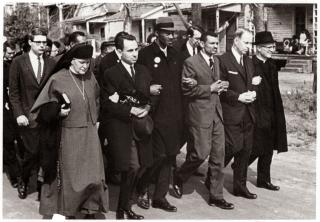Advertisement
1960s
1960 Joint assemblies of the Universalist Church of America and the American Unitarian Association approve consolidation.
1961 The Unitarian Universalist Association is born. The Rev. Dana McLean Greeley, former AUA president, is elected president. A new hymnal, Hymns for the Celebration of Life, is published in 1964.
1965 UUs rally to the aid of the civil rights movement. Two—the Rev. James Reeb and Viola Liuzzo—are killed during the Selma voting rights struggle. Greeley and many other UU leaders march in Selma (see photo above). [In 2011, the FBI reopened an investigation into Reeb's killing.]
1967–1970 The “black empowerment controversy” divides UUs about approaches to racial justice and UUA finances. The 1968 General Assembly pledges $1 million to black empowerment projects. In 1969, after the Rev. Robert Nelson West is elected president and the UUA is found to be deep in debt, the UUA cuts funding. In 1970, the General Assembly eliminates black empowerment funding entirely, alienating many black UUs.
1970s
1970 President West makes deep cuts to the UUA’s budget. The UUA stops publishing a subscription-only magazine, and starts publishing Unitarian Universalist World—a newspaper sent to every member, and the precursor of this magazine. The UUA also publishes its candid About Your Sexuality curriculum for teens.
1971 The UUA’s Beacon Press publishes the complete text of the leaked Pentagon Papers, which reveals the government’s bleak assessment of the Vietnam War. UUA President West and Sen. Mike Gravel, who released the documents into the public record, protest the FBI’s attempt to seize UUA bank records. An expensive legal fight continues until U.S President Richard Nixon resigns in 1974.
1971 A Long Island church—now the UU Congregation at Shelter Rock in Manhasset, New York—helps restore the UUA’s finances with major loans and grants from the bequest of Caroline Veatch. Its Veatch Program sets up a $20 million endowment fund for the UUA in 1985. The program continues to support the UUA, other UU organizations, and social justice programs with grants each year.
1977 The General Assembly adopts the Women and Religion Resolution, pledging to challenge sexist language, assumptions, and practices. Curricula (such as Cakes for the Queen of Heaven), new worship practices (like the water ceremony), and revised texts follow. In 1977, only 5 percent of UU clergy are women; today more than half of UU ministers are women. The Rev. Paul Nathaniel Carnes is elected president, but dies in office two years later.
1979 The Rev. O. Eugene Pickett is elected president; he completes the UUA’s first capital campaign. During his tenure, Unitarian Universalism begins to grow again after a decade in decline.
1980s
1985 The General Assembly adopts new Principles and Purposes for the first time since 1961, giving us today’s Seven Principles and five of the Six Sources; the sixth was added in 1995. The flaming chalice, introduced by the Unitarian Service Committee during World War II and first used as a denominational logo in 1976, becomes a ritual part of many worship services in the 1980s. The UUA’s newspaper becomes World magazine in 1986.
1987 The Rev. Dr. William F. Schulz, UUA president, and Moderator Natalie Gulbrandsen, elected in 1985, lead a delegation to Transylvania, the region in formerly Communist Romania where Unitarian communities had flourished since the sixteenth century. Partnerships between North American and Transylvanian congregations are revived, and the Partner Church Council is formed.
1989 The Welcoming Congregation program is introduced, helping congregations genuinely embrace gay, lesbian, bisexual, and transgender people. A majority of congregations have now completed the program. (Support for LGBT issues began with a General Assembly resolution in 1970; a vote in 1974 established a denominational office to add programmatic support.)
1990s
1992 The General Assembly commits the UUA to becoming “racially and culturally diverse” and in 1997 votes to become an “anti-racist, multicultural association.” Anti-racism training is incorporated into governance, staff, and ministry training.
1993 Singing the Living Tradition, the UUA’s gender-inclusive hymnal, is published. The Rev. John A. Buehrens is elected president.
1995 The UUA launches its website, UUA.org. The International Council of Unitarians and Universalists is formed as a representative body of UU groups that now includes more than twenty countries.
1999 The UUA, with the United Church of Christ, introduces a new comprehensive sexuality curriculum, Our Whole Lives.
2000s
2001 The Rev. William G. Sinkford is elected UUA president, the first African American in that office. He brings greater publicity to the Association’s public witness work.
2002 The Canadian Unitarian Council takes responsibility for services to Canadian congregations and many Canadian congregations withdraw from the UUA, which now focuses on U.S. congregations.
2004 Julie and Hillary Goodridge, lead plaintiffs in the court case legalizing same-sex marriage in Massachusetts, are married at UUA headquarters. (The General Assembly endorsed marriage equality in 1996.) UU congregations champion equal marriage rights across the country.
2007 The UUA’s religious education materials move away from printed lesson books to an online, flexible comprehensive curriculum with Tapestry of Faith, with more than twenty programs.
2009 The Board of Trustees adopts Policy Governance® as the UUA’s governance model and begins introducing a series of governance reforms. The Rev. Peter Morales is elected president, the UUA’s first Latino president. Through its Standing on the Side of Love campaign, the UUA champions LGBT rights and the rights of immigrants.
Companion Articles
Corrections
5.16.11: The print edition of this article misstated the year of the first same-sex marriages in the U.S. Although the Supreme Judicial Court of Massachusetts expanded marriage rights in 2003, its ruling declared that gay marriage could begin in May 2004.
